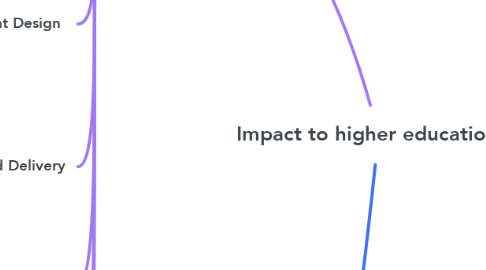
1. Impact
1.1. Personalized Learning
1.1.1. Adaptive Assessment
1.1.1.1. Continually assessing a student's grasp of the material and adapting instructional strategies accordingly.
1.1.2. Pace Adaptation
1.1.2.1. Allowing students to learn at their own pace, ensuring thorough understanding before moving onto next topics.
1.1.3. Tailoring Curriculum to Individual Needs
1.1.3.1. Adapting the learning material to suit the capabilities and interests of each student.
1.2. Enhanced Accessibility
1.2.1. Assistive Technologies
1.2.1.1. Utilizing AI to provide assistive technologies for differently-abled students.
1.2.2. Language Translation and Transcription
1.2.2.1. Making materials accessible to non-native speakers or hearing-impaired students.
1.2.3. Flexible Learning Environments
1.2.3.1. Enabling access to educational resources anytime, anywhere.
1.3. Intelligent Tutoring System
1.3.1. Real-Time Feedback
1.3.1.1. Providing immediate feedback to students, aiding in their learning process.
1.3.2. Personalized Tutoring
1.3.2.1. Offering personalized guidance and instructions based on individual student performance.
1.3.3. Knowledge Assessment
1.3.3.1. Continuously assessing a student's knowledge and understanding of the material.
1.4. Assessment/Evaluation
1.4.1. Continuous Assessment
1.4.1.1. Regular assessments to gauge student understanding and performance.
1.4.2. Summative Assessment
1.4.2.1. Evaluations at the end of an instructional period to measure student learning.
1.4.3. Formative Assessment
1.4.3.1. Ongoing assessments to identify areas of improvement and adapt instruction.
1.4.4. Peer Assessment
1.4.4.1. Evaluations conducted by peers to provide different perspectives and feedback.
1.5. Predicting Academic Progress
1.5.1. Early Alert Systems
1.5.1.1. Identifying students at risk of falling behind early on to provide necessary support.
1.5.2. Predictive Analytics
1.5.2.1. Utilizing data to predict future academic performance and potential challenges.
1.5.3. Adaptive Learning Paths
1.5.3.1. Adjusting learning trajectories based on past performance to optimize future academic success.
1.6. Creative Assignment Design
1.6.1. AI-Assisted Assignment Creation
1.6.1.1. Utilizing AI to create engaging and challenging assignments.
1.6.2. Real-Time Assignment Adaptation
1.6.2.1. Adapting assignments in real-time based on student performance and understanding.
1.6.3. Peer Interaction Enhancement
1.6.3.1. Designing assignments that promote peer interaction and collaborative learning using AI.
1.7. Education Management and Delivery
1.7.1. Curriculum Design
1.7.1.1. Utilizing AI to design and adapt curriculum based on student needs and performance.
1.7.2. Resource Allocation
1.7.2.1. Efficiently allocating resources based on real-time data to enhance education delivery.
1.7.3. Administration Automation
1.7.3.1. Automating administrative tasks to allow educators to focus more on instruction.
1.8. Syllabi Update
1.8.1. Syllabus Generation
1.8.1.1. Utilizing AI to generate or update syllabi based on course requirements and goals.
1.8.2. Real-Time Syllabus Adjustment
1.8.2.1. Adapting the syllabus in real-time based on class progress and feedback.
1.9. Future-Oriented Mindset Development for Educators
1.9.1. Adaptive Pedagogy
1.9.1.1. Developing skills to adapt teaching methodologies in tandem with evolving AI technologies.
1.9.2. Continuous Professional Development
1.9.2.1. Encouraging a culture of continuous learning and adaptation to technological advancements.
1.10. Creation of knowledge
1.10.1. Accelerating across disciplines
1.10.2. The problem of keeping currency
2. External threats
2.1. Current perception of the value of higher education
2.2. Methodological biases
2.2.1. Sampling
2.2.1.1. What data was used for the training?
2.2.2. Face validity
2.2.2.1. "Big data" lacks universality
2.3. Ideological biases
2.3.1. Over-reliance on quantitative methods to make assessments of reality
2.3.1.1. Reasons
2.3.1.1.1. Computers are really fast
2.3.1.1.2. Computers are amazing at crunching numbers
2.3.1.1.3. AI will provide amazing statistics
2.3.1.2. Thoroughly explained by Neil Postman
2.3.1.2.1. https://en.wikipedia.org/wiki/Technopoly
2.3.1.3. Still it doesn't capture the full essence of human nature
2.3.1.4. Determinism
2.3.2. Increasing efficiency
2.3.3. Reducing cost
